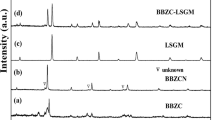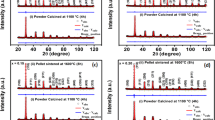Abstract
Single phase polycrystalline BaZr0.3Ce0.5Y0.1Yb0.1O3 - δ electrolyte material was prepared by solid state reaction route. Rietveld analysis of the XRD data confirms the tetragonal symmetry in the I4/mcm space group with unit cell parameters of a = b = 6.0567(3) Å and c = 8.5831(5) Å. The addition of ZnO as a sintering additive was found to reduce the sintering temperature and enhance both overall sinterability and grain growth. Sintering temperature was reduced by 200–300 °C, and a very high relative density of about 98% was achieved at 1400 °C. Impedance spectroscopy in humidified 5% H2/Ar atmosphere shows that the protonic conductivity at 600 °C was 8.60 × 10−3 S cm−1. Thermal analysis performed in pure CO2 atmosphere shows very good chemical stability up to 1200 °C. Good biaxial flexure strength of 100–200 MPa was reported which makes this material a promising electrolyte material for intermediate temperature solid oxide fuel cells (IT-SOFCs).







Similar content being viewed by others
References
Fabbri E, Bi L, Rupp JLM, Pergolesi D, Traversa E (2011) Electrode tailoring improves the intermediate temperature performance of solid oxide fuel cells based on a Y and Pr co-doped barium zirconate proton conducting electrolyte. RSC Adv 1(7):1183–1186
Radenahmad N, Afif A, Petra PI, Rahman SMH, Eriksson S-G, Azad AK (May 2016) Proton-conducting electrolytes for direct methanol and direct urea fuel cells—a state-of-the-art review. Renew Sust Energ Rev 57:1347–1358
Duan C, Tong J, Shang M, Nikodemski S, Sanders M, Ricote S, Almansoori A, O’Hayre R (Sep. 2015) Readily processed protonic ceramic fuel cells with high performance at low temperatures. Sci. 349(6254):1321–1326
Norby T (Apr. 2001) The promise of protonics. Nature 410(6831):877–878
Yamazaki Y, Blanc F, Okuyama Y, Buannic L, Lucio-Vega JC, Grey CP, Haile SM (Jul. 2013) Proton trapping in yttrium-doped barium zirconate. Nat Mater 12(7):647–651
Fabbri E, Pergolesi D, Traversa E (2010) Materials challenges toward proton-conducting oxide fuel cells: a critical review. Chem Soc Rev 39(11):4355–4369
Medvedev D, Murashkina A, Pikalova E, Demin A, Podias A, Tsiakaras P (Mar. 2014) BaCeO3: materials development, properties and application. Prog Mater Sci 60:72–129
Iwahara H, Esaka T, Uchida H, Maeda N (Aug. 1981) Proton conduction in sintered oxides and its application to steam electrolysis for hydrogen production. Solid State Ionics 3–4:359–363
Kreuer KD (2003) Proton-conducting oxides. Annu Rev Mater Res 33(1):333–359
Azad AK, Kruth A, Irvine JTS (2014) Influence of atmosphere on redox structure of BaCe 0.9 Y 0.1 O 2.95—insight from neutron diffraction study. Int J Hydrog Energy 39(24):12804–12811
Zuo C, Zha S, Liu M, Hatano M, Uchiyama M (Dec. 2006) Ba(Zr0.1Ce0.7Y0.2)O3–δ as an electrolyte for low-temperature solid-oxide fuel cells. Adv Mater 18(24):3318–3320
Bi L, Tao Z, Liu C, Sun W, Wang H, Liu W (2009) Fabrication and characterization of easily sintered and stable anode-supported proton-conducting membranes. J Memb Sci 336:1–6
Yang L, Wang S, Blinn K, Liu M, Liu Z, Cheng Z, Liu M (Oct. 2009) Enhanced sulfur and coking tolerance of a mixed ion conductor for SOFCs: BaZr0.1Ce0.7Y0.2–xYbxO3–δ. Sci 326(5949):126–129
Liu Y, Yang L, Liu M, Tang Z, Liu M (2011) Enhanced sinterability of BaZr0.1Ce0.7Y0.1Yb0.1O3−δ by addition of nickel oxide. J Power Sources 196(23):9980–9984
Yang L, Wang S, Blinn K, Liu M, Liu Z, Cheng Z, Liu M (2009) Enhanced sulfur and coking tolerance of a mixed ion conductor for SOFCs: BaZr(0.1)Ce(0.7)Y(0.2-x)Yb(x)O(3-delta). Science 326(5949):126–129
Shi Z, Sun W, Liu W (Jan. 2014) Synthesis and characterization of BaZr0.3Ce0.5Y0.2−xYbxO3−δ proton conductor for solid oxide fuel cells. J Power Sources 245:953–957
Mirfakhraei B, Ramezanipour F, Paulson S, Birss V, Thangadurai V (2014) Effect of sintering temperature on microstructure, chemical stability, and electrical properties of transition metal or Yb-doped BaZr0.1Ce0.7Y0.1M0.1O3−δ (M = Fe, Ni, co, and Yb). Front Energy Res 2:9
Katahira K, Kohchi Y, Shimura T, Iwahara H (2000) Protonic conduction in Zr-substituted BaCeO3. Solid State Ionics 138(1–2):91–98
Azad AK, Irvine JTS (2007) Synthesis, chemical stability and proton conductivity of the perovksites Ba(Ce,Zr)1-x Scx O3 - d. Solid State Ionics 178(7–10):635–640
Babilo P, Haile SM (2005) Enhanced sintering of yttrium-doped barium zirconate by addition of ZnO. J Am Ceram Soc 88(9):2362–2368
Gorbova E, Maragou V, Medvedev D, Demin A, Tsiakaras P (2008) Investigation of the protonic conduction in Sm doped BaCeO3. J Power Sources 181(2):207–213
Tao S, Irvine JTS (2006) A stable, easily sintered proton-conducting oxide electrolyte for moderate-temperature fuel cells and electrolyzers. Adv Mater 18(12):1581–1584
Li Y, Guo R, Wang C, Liu Y, Shao Z, An J, Liu C (2013) Stable and easily sintered BaCe0.5Zr0.3Y0.2O3−δ electrolytes using ZnO and Na2CO3 additives for protonic oxide fuel cells. Electrochim Acta 95:95–101
Azad AK, Setsoafia DDY, Ming LC, Petra PMI (2015) Synthesis and characterization of high density and low temperature sintered proton conductor BaCe0.5Zr0.35In0.1Zn0.05O3-d. Adv Mater Res 1098:104–109
Azad AK, Irvine JTS (2008) High density and low temperature sintered proton conductor BaCe 0.5Zr0.35Sc0.1Zn0.05O 3-d. Solid State Ionics 179(19–20):678–682
Stevenson DA, Jiang N, Buchanan RM, Henn FEG (1993) Characterization of Gd, Yb and Nd doped barium cerates as proton conductors. Solid State Ionics 62(3–4):279–285
Rodriguez-Carvajal J (1993) Recent advances in magnetic structure determination by neutron powder diffraction + FullProf. Phys B Condens Matter 192(1--2):55
Fabbri E, D’Epifanio A, Di Bartolomeo E, Licoccia S, Traversa E (2008) Tailoring the chemical stability of Ba(Ce0.8-xZrx)Y0.2O3-delta protonic conductors for intermediate temperature solid oxide fuel cells (IT-SOFCs). Solid State Ionics 179(15–16):558–564
Guo Y, Lin Y, Ran R, Shao Z (2009) Zirconium doping effect on the performance of proton-conducting BaZryCe0.8−yY0.2O3−δ (0.0≤y≤0.8) for fuel cell applications. J Power Sources 193(2):400–407
Sawant P, Varma S, Wani BN, Bharadwaj SR (2012) Synthesis, stability and conductivity of BaCe0.8−xZrxY0.2O3−δ as electrolyte for proton conducting SOFC. Int J Hydrog Energy 37(4):3848–3856
Azad AK, Savaniu C, Tao S, Duval S, Holtappels P, Ibberson RM, Irvine JTS (2008) Structural origins of the differing grain conductivity values in BaZr0.9Y0.1O2.95 and indication of novel approach to counter defect association. J Mater Chem 18(29):3414
Tao S, Irvine JTS (2007) Conductivity studies of dense yttrium-doped BaZrO3 sintered at 1325 °C. J Solid State Chem 180(12):3493–3503
Guo Y, Ran R, Shao Z (2010) Optimizing the modification method of zinc-enhanced sintering of BaZr 0.4Ce0.4Y0.2O3-δ-based electrolytes for application in an anode-supported protonic solid oxide fuel cell. Int J Hydrog Energy 35(11):5611–5620
Zhang C, Zhao H, Xu N, Li X, Chen N (2009) Influence of ZnO addition on the properties of high temperature proton conductor Ba1.03Ce0.5Zr0.4Y0.1O3−δ synthesized via citrate–nitrate method. Int J Hydrog Energy 34(6):2739–2746
Lv J, Wang L, Lei D, Guo H, Kumar RV (2009) Sintering, chemical stability and electrical conductivity of the perovskite proton conductors BaCe0.45Zr0.45M0.1O3−δ (M = in, Y, Gd, Sm). J Alloys Compd 467(1–2):376–382
Shi Z, Sun W, Wang Z, Qian J, Liu W (2014) Samarium and yttrium codoped BaCeO3 proton conductor with improved sinterability and higher electrical conductivity. ACS Appl Mater Interfaces 6(7):5175–5182
Ricote S, Bonanos N, Caboche G (2009) Water vapour solubility and conductivity study of the proton conductor BaCe(0.9 − x)ZrxY0.1O(3 − δ). Solid State Ionics 180(14–16):990–997
Uchida H, Maeda N, Iwahara H (1983) Relation between proton and hole conduction in SrCeO3-based solid electrolytes under water-containing atmospheres at high temperatures. Solid State Ionics 11(2):117–124
Lee W, Nowick A, Boatner L (Jan. 1986) Protonic conduction in acceptor-doped KTaO3 crystals. Solid State Ionics 18–19:989–993
Malavasi L, Fisher CAJ, Islam MS (2010) Oxide-ion and proton conducting electrolyte materials for clean energy applications: structural and mechanistic features. Chem Soc Rev 39(11):4370–4387
Kannan R, Singh K, Gill S, Fürstenhaupt T, Thangadurai V (2013) Chemically stable proton conducting doped BaCeO3—no more fear to SOFC wastes. Sci Rep 3:2138
Matsumoto H, Kawasaki Y, Ito N, Enoki M, Ishihara T (Apr. 2007) Relation between electrical conductivity and chemical stability of BaCeO3-based proton conductors with different trivalent dopants. Electrochem Solid-State Lett 10(4):B77–B80
Reddy KR, Karan K (2005) Sinterability, mechanical, microstructural, and electrical properties of gadolinium-doped ceria electrolyte for low-temperature solid oxide fuel cells. J Electroceram 15(1):45–56
Atkinson A, Selçuk A (2000) Mechanical behaviour of ceramic oxygen ion-conducting membranes. Solid State Ionics 134(1–2):59–66
Acknowledgements
The authors are grateful for the financial help from the S & T grant no.17. They are a lot grateful to the help and cooperation from JTSI research group, School of Chemistry, University of St-Andrews. One of the authors, M Naeem Khan, is grateful for the Graduate Research Fellowship of Universiti Brunei Darussalam.
Author information
Authors and Affiliations
Corresponding author
Rights and permissions
About this article
Cite this article
Naeem Khan, M., Azad, A., Savaniu, C. et al. Robust doped BaCeO3-δ electrolyte for IT-SOFCs. Ionics 23, 2387–2396 (2017). https://doi.org/10.1007/s11581-017-2086-x
Received:
Revised:
Accepted:
Published:
Issue Date:
DOI: https://doi.org/10.1007/s11581-017-2086-x




